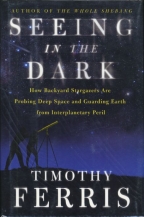Seeing in the Dark: How Backyard Stargazers Are Probing
Deep Space and Guarding Earth from Interplanetary Peril
Simon & Schuster
US Hardcover
ISBN 0-684-86579-3
Publication Date: 09-05-2002
380 Pages; $26.00
Date Reviewed: 09-11-02
Reviewed by Rick Kleffel © 2002
|

|
|
REFERENCES
|
COLUMNS
|
|
Non-Fiction,
Science
Fiction
|
09-11-02
|
The typical picture of the astronomer in my mind, and the minds of
most readers, is that of a tall man wearing a white lab coat and
carrying a clipboard, occasionally bending over to peer into the
eyepiece of an enormous, expensive telescope in a remote mountaintop
location. This is the scientist at his most scientific, a man who
never leaves the earth but only studies that which never comes to
earth. This is remote and academic, accomplished and incredibly
intellectual. This is patient and productive, professional and
professorial. But there are scores of astronomers who are anything
but professional or professorial, and yet they are making huge
contributions to the science. A case in point is the gentleman who
only yesterday announced that he had discovered that the earth has a
second moon. In 'Seeing in the Dark: How Backyard Stargazers Are
Probing Deep Space and Guarding Earth from Interplanetary Peril',
author Timothy Ferris makes a case for the amateur astronomer's
contributions to science. But most importantly, he tells a compelling
tale of interesting people in gorgeous language. Whether you're
interested in astronomy or not -- and it's hard to come away from
this book without being interested in astronomy -- the people and the
language that Timothy Ferris summons are a compelling reason to read
this book.
I haven't read Ferris' other work, though I might be inclined to
do so now. But 'Seeing in the Dark' is certainly not what I expected
of a "popular science" book about astronomy. It's a very personal
seeming work, which begins with Ferris' reminiscences of his Florida
childhood, building models of rockets and looking at the stars. He
then heads out on a carefully crafted tour of the universe, via the
amateur astronomers who are studying it. The book is very cleverly
written so that no section is dauntingly long, and each is filled
with portraits of the fascinating people who are studying the
stars.
These portraits of the people are interspersed with advice and
effective inspiration to get the reader out and looking at the sky,
even if you're only using your bare eyes. Ferris is gifted at giving
the reader hints on how to make the transition from clueless novice
to interested amateur. For example, one suggestion he has is that the
beginner make a list of what he intends to see on a given night. It's
something that might never have occurred to me, but in itself it
really pulls the whole enterprise out of the hall closet and onto the
back porch. Ferris debunks the myths that you need an ultimately
clear pitch black sky to see interesting astronomical phenomena. In
fact, you can even gather crucial scientific data in a citified sky.
And he interleaves his suggestions with personal anecdotes and ten
years worth of interviews that he manages to string together
seamlessly, to create a big complicated picture that is disarmingly
easy to read.
Ferris is credited with publication in The New Yorker, and it's
easy to see why. His prose constantly verges on poetic, and he's
remarkably capable of turning science into entertainment. As we visit
with Stephen O'Meara, the man with simply remarkable eyes, or John
Dobson, the San Francisco monk who invented a whole new class of
telescopes and plunked them down in the city streets to delight
passers-by with the rings of Saturn. If you are remotely interested
in astronomy or in reading about fascinating, slightly odd people,
then 'Seeing in the Dark' is likely to reward you with view not only
of the universe, but the remarkable humans who gaze upon it.
